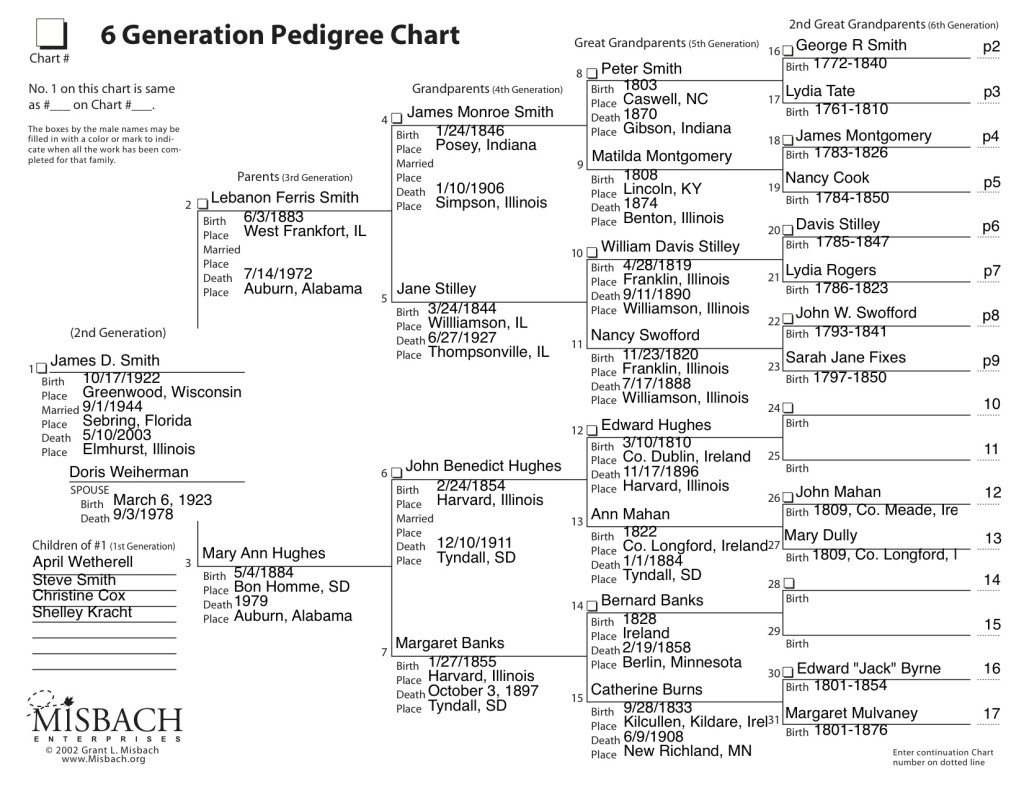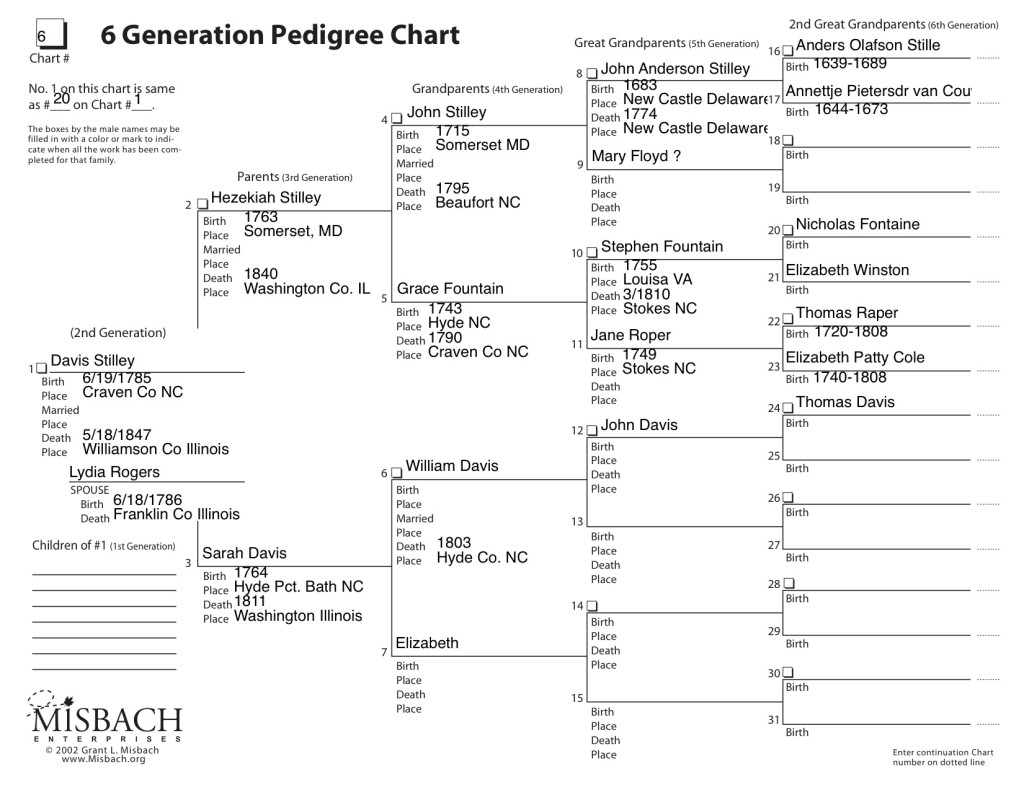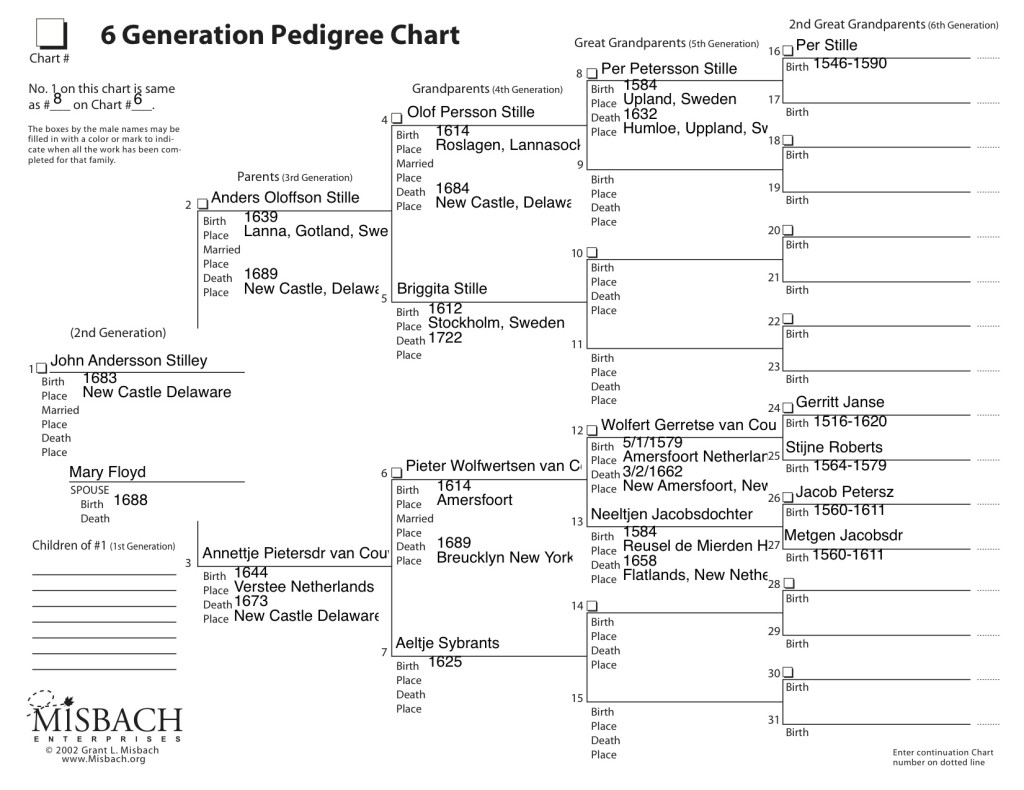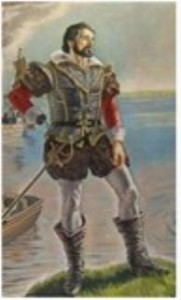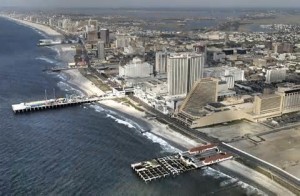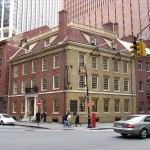The Smith/Stilley/Davis Branch
As the American Revolutionary War was shaping a nation, Hezekiah Stilley married the girl next door, Sarah Davis, daughter of war veteran, William Davis. Several generations of the Davis family had forged a trail from Jamestown, Virginia through various river valleys leading to the shores of Pamlico Sound in Hyde County, North Carolina. Sarah and Hezekiah would continue that journey from the Atlantic Coast to the rolling hills of Southern Illinois, the first of a wave of farm families to settle into “Indian Country”, in what had been Quebec, Canada (1763), the Northwest Territory of the new United States of America (1783), and in 1803, the Indiana Territory.
Two hundred years earlier, in 1583 Robert Davis was the master of Sir Walter Raleigh’s vessel, the ‘Rawley’ which sailed in Sir Humfrey Gilbert’s expedition to Newfoundland. It was the Age of Exploration and Gilbert was looking for the Northwest Passage through the Arctic Ocean to Cathay (China). He also intended to seize 9 million acres of Newfoundland property with the approval of the Queen of England, Elizabeth, and claim it for England. Sir Humfrey Gilbert (a distant relative), had recently annihilated the population of Ireland in his quest to destroy the Fitzgeralds (our Irish ancestors). Having conquered Ireland it was generally expected that he would be named the overseer of the island. A man of many talents and a troubled mind, Gilbert and his half brother, Sir Walter Raleigh, turned their attention to the colonization of the New World. Gilbert had his heart set on developing two schemes: colonies in the New England area and in the Virginia/Carolina coastal region. On his return voyage from Newfoundland, Gilbert lost his life on his ship, the “Squirrel”. The small ship was overwhelmed by massive waves and all aboard were lost as the ship sank to the bottom of the Atlantic Ocean. Another of our great grandfather’s families, the Grenvilles, picked up where Gilbert left off. They established what became the lost colony of Roanoke Island in the Carolinas.
Key among the captains that piloted English ships were members of the Davis family: John, James and Robert. James and Robert were involved in the early settlement of first Maine and then Virginia. The British had been inspired by stories of Norumbega, a colony established by the Vikings in the year 1000. French navigator Jean Allefonsce (1542) had sailed the New England coast south from Newfoundland and discovered a great river, called by natives the Norumbega. He sailed up the river and found a city of tall white people who spoke a language that “sounded like Latin.” Later explorers believed the river was what they would be calling the Penobscot.
Born around 1580 in Gloucester, England, James Davis was the son of Sir Thomas Davis, an original member of the Virginia Company of Plymouth, England. Fifty years after the voyage of Allefonsce, the Virginia Company was determined to go forward with a colony at the mouth of the Kennebec River in present day Maine. James and Robert Davis became responsible for developing Fort Sagadahoc. James Davis, a bit of a Renaissance Man, provides us with a vivid account of the voyage in his journal, “Relation of a Voyage to Sagadahoc, 1607-1608.” He returned to England in the late summer of 1607. From the beginning the Sagadahoc venture was a flop. The colonists arrived too late to plant crops and did not have sufficient supplies to endure a bitter winter. Relations with the native population went down hill, attacks took place and folks were killed. The endeavor collapsed and the colonists decided there was only one solution. They cut timbers, crafted a 50 foot ship and christened it “Virginia”. When Davis returned to Maine from England he guided the surviving colonists back to England on the Virginia. The Pilgrims on the Mayflower (1620) would be the next to establish a British colony in New England.
James Davis didn’t sit still for very long. He was needed in Jamestown, Virginia. On June 18, 1609 nine ships set sail from England in what was called The Third Supply. Davis guided the Virginia. The ships were transporting supplies and more settlers to the colony. Jamestown was struggling for survival. The ships faced their own struggles at sea. Hurricanes were something new in the life of a British sailor. High winds, between the Canary Islands and Bermuda sank one ship (the Catch) and all on board were lost. A second ship, the Sea Adventure, limped into Bermuda and was disassembled. Two ships were created out of her parts: the Deliverance and the Patience. Davis and his ship, The Virginia, was blown off course, struggled to survive and arrived two months after the fleet of ships. Captain John Smith had little use for James Davis and was unmoved by his arrival and survival. Smith worked for the London Company and Davis for the Plymouth Company. The newly created ships, Deliverance and Patience, arrived from Bermuda a year later. Their appearance in the harbor at Jamestown stunned the colonists who assumed the Sea Adventure and all aboard had been lost at sea.
Once he got his feet on the ground in Jamestown, Davis stayed put for awhile. He took charge of Fort Algernon. It was a dangerous assignment. Chief Powhatan had captured his predecessor, Captain John Ratcliffe, and had him skinned alive and burned at the stake. Davis would take no chances with his adversary and was aggressive, and some times ruthless, in his attacks on the tribal villages in the area. He secured the region for the time and the British counted on his military leadership as they developed forts and went toe to toe with the Powhatan and his tribe. Attacks and counter attacks were now commonplace.
Starvation gripped Jamestown in 1609. A village of 500 was decimated and down to 50 residents. While food was in short supply in the colony, James Davis and his garrison of twenty survived in a hearty manner. Twenty miles removed from Jamestown and sitting on the Chesapeake Bay, Davis and his men had a steady supply of seafood and were, in fact, able to keep their hogs well fed on crab meat. When Captain Percy of Jamestown visited the fort to see how everyone was doing, he was stunned to find everyone healthy and strong. Starvation was not an issue. In his journal Percy expresses his anger. He believed Davis knew of the difficulties in Jamestown and deliberately withheld food from the colony. He immediately ordered Davis to provide food, care and shelter for all of Jamestown and return all to good health. Apparently Davis had little use for John Smith as well. That was Percy’s perception.
James Davis needed to step back in his later years and he settled into one of the first plantations in the American colonies. He followed a model established in Ireland by his relative, Sir Humfrey Gilbert. Gilbert stole land from the native Irish farmers and organized large plantations, farms, granted to the wealthy upper class Lords of England. With similar deeds (patents) granted by King James of England, the upper crust of Jamestown and new arrivals, now developed plantations which would nurture and grow tobacco. Cotton would soon follow, as would much needed help in the form of slaves, brought in chains from Africa. It was the beginning of an era in world history that would change forever the culture of the new world. Amidst all of his adventures, James Davis had married Rachell Keyes and together they raised their children, including Thomas, on the shores of the James River. Places like Henrico, Nansemond and Albemarle would become prominent locations that housed their descendants.
Eventually the Davis name would move south into Perquimans, Pasqoutank, Rowan and Beaufort Counties of North Carolina. Davis Plantations were commonplace and changed hands by sale of deed and the power of attorney in wills. The lives of the black humans who served as slaves to the white owner, also changed hands in the wills left by the deceased. Land, chairs, a piece of silver plating and a negra girl named Liza could be left to the son or daughter of a plantation owner. In the case of William Davis (1803) after assigning his land to various sons and blacksmith tools to a grandson he then turned to the matter of his slaves and gave “my slave Jemima, to my beloved wife, Elizabeth, to her and her heirs forever.” Forever was a long time. It was as if folks were handing down a good shovel or kitchen table. To his “son, John Davis my negro boy named Gabrel….. to my son William Davis a negro boy named Joseph….. to my son Richard Davis a negro boy named Moses……to my daughter Lydia Davis a negro girl named Kesiah….. to her and her heirs forever.” And then to drive the point home that a black human being was chattel, the decent Christian plantation owner did “lend my negro woman named Cate to my beloved wife during her life and afterwards I give her to my son Jesse Davis, I also give to my son Jesse my negro woman named Judith and my negro girl named Silard.”
William’s plantation was profitable and the census records for Hyde County, NC for 1790 and 1800 reveal that there were plantations with more slaves, but not many. Certainly the Gibbs family ran a much larger operation with five times the number of slaves. What is not so apparent is whether or not William was breaking up a black family when he apportioned his “property.” It might be assumed that Judith and Silard were mother and daughter. But what of the young boys who were doled out, one here one there? Were they Judith’s sons? Was Cate a mother to one of the boys? Was Jemima the mother of Gabrel? Moses? Joseph? Who did Kesiah part from when she was handed over to Lydia Davis? Or had these children been separated at the slave sale block in the Charleston Harbor upon arrival in the colony? Perhaps, like Kunta Kinte in the epic Roots (Alex Haley) they were kidnapped from their home in Africa. And speaking of Kunta Kinte…. the very Christian captain of the ship that brought Kunta Kinte to America was Captain Thomas Davis of the seafaring Davis family. Another grandparent? No. But more than likely a part of the family tree.
When slavery was abolished following the Civil War, the now free black men and women were allowed their independence and could struggle to make an independent living. Their last names were often the surname of their previous slave master/owner. Thus to this day, there are a large number of Davis family members whose ancestors lived in a shanty behind the plantation homes of William Davis and his kin.
My grandfather, Leb Smith, once commented that he didn’t want to know much about his ancestors. He said, “I am afraid I will find more horse thieves than judges.” Unfortunately, the Davis family was not the largest slaveholding plantation owner in my Smith family tree. In digging into the Smith surname I found a great grandfather, Peter Smith of Round Hill Plantation, Caswell County, North Carolina. We will come back to Peter at a later date. And if Caswell County sounds familiar to those of you who read Roots; the answer is: Yes, it was the North Carolina county that was home to Chicken George.


